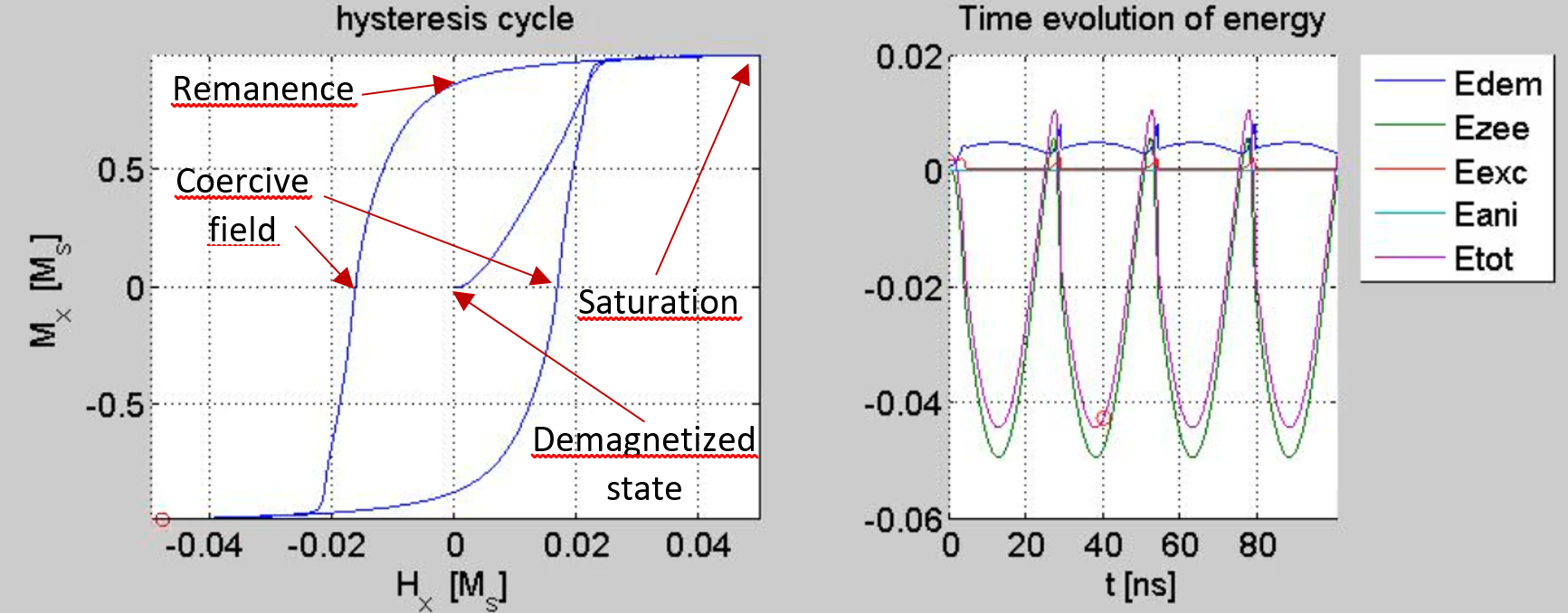| Massimiliano d'Aquino | 
|
| Welcome to my web pages! | Università degli Studi di Napoli Federico II |
Movies |
|
| Menu Home Research Presentations Publications Ph.D Thesis Links Gallery Short CV |
Preliminaries - Understanding Magnetic
Hysteresis
Hysteresis
is produced, in general, by the existence of multiple equilibrium states. In
the magnetic case, an equilibrium magnetization configuration is associated
with a local minimum of suitable thermodynamic potential termed micromagnetic free energy.
The free energy is composed of several contributions: - short-range
interactions which constitute the ‘energy of the matter’, such as exchange and
anisotropy. - long
range (Maxwellian), such as magnetostatic and Zeeman (interaction with external
field) interactions. Each interaction
would favor a different magnetic equilibrium, so the actual one will be every
time the result of a compromise among all these free energy contributions. Exchange
will favor spatially uniform magnetization (domains) regardless of their
orientation, anisotropy will favor/inhibit certain easy/hard directions,
magnetostatics will try to minimize magnetic charges and Zeeman will favor
alignment of the domains with the external field. Let us see
it with a simple example. (1) Now, if we
apply a field along the x axis, domains aligned with the field (red) are
favored (Zeeman energy) and will start to grow (fig. 2). (3) When the
field is large enough, the material will be monodomain and aligned with
the
field (saturation, fig. 3), thus the memory of the past domain
structure will
be lost. In fact, decreasing the field back will produce different
sequence of
magnetization configurations. An interesting one is the so-called
remanence,
when the applied field is zero (fig. 4) while magnetization is not.
This is the
main mechanism of magnetic memory which retains information (e.g. the
bit "0" or "1") without need of
external energy supply, as presently applied in Hard Disk Drives in
datacenters for cloud storage each capable of storing Terabytes of
binary information. In this situation, the Zeeman energy is zero, so
the
equilibrium is a trade-off between exchange (that would like single
domain) and
magnetostatics (which would like zero magnetic volume and surface
charges). Minimizing
the magnetostatic energy results in a remanence aligned with the long
dimension
of the film and with magnetization tilting at the edges (S-state). Decreasing the
field below zero, one arrives at a configuration with zero magnetization, which
is associated with the so-called coercive field (fig.5). Now it is apparent
that a domain structure has formed again as a result of free energy
minimization. Further decreasing the field produces the approach to negative
saturation and new cancellation of the past memory of magnetization (fig. 6). (5) Now incresing the field again, the system will have a
symmetrical ascending branch of the hysteresis loop, as it can be seen below
(fig. 7). (7) In the following, I show some demostrations of magnetization dynamics obtained by micromagnetic simulations performed with my numerical code Ma.GI.Co. (Magnetization Geometrical Integration Code). Details can be found in the paper M. d’Aquino, C. Serpico, G. Miano, “Geometrical Integration of Landau-Lifshitz-Gilbert equation based on the mid-point rule”, Journal of Computational Physics 209 (2005), 730-753. Video 1 - Magnetic thin-film Hysteresis Loop This is a quasi-static process. A Permalloy rectangular thin-film 750x500x5 nm3 with saturation magnetization 800kA/m (corresponding to a magnetic induction 1Tesla) is considered. The initial equilibrium configuration is a demagnetized state of vortex-type. The external field is applied along the x direction (two periods of sine wave with period T=50 ns, peak amplitude 50mT) with a small bias along the y axis in order to break the symmetry. The hysteresis loop of the thin-film is computed. The applied field maximum amplitude is enough to saturate the sample and cancel the memory of the initial demagnetized state. One can observe domain nucleation and wall motion occurring at certain field amplitudes. Left panel reports magnetization x component as function of applied field x component. Right panel reports time evolution of micromagnetic free energy contributions. Description of such contribution can be found here. Video 2 - Magnetic thin-film with vortex wall This is a quasi-static process. A Permalloy rectangular thin-film 1024x256x4 nm3 with saturation magnetization 800kA/m (corresponding to a magnetic induction 1Tesla) is considered. The thin-film has magneto-crystalline anisotropy along the transverse y axis, with uniaxial anisotropy constant K1=104 J/m3. The initial equilibrium configuration is a demagnetized state of vortex-wall type. The AC external field is applied along the x direction (the period of the sine wave is T=400 ns, peak amplitude 30mT) with a small bias along the y axis in order to break the symmetry. The hysteretic response of the thin-film is computed. It is apparent that the applied field amplitude is not enough to cancel the memory of the initial equilibrium. One can observe domain nucleation and wall motion occurring at certain field amplitudes. Left panel reports magnetization x component as function of applied field x component. Right panel reports time evolution of micromagnetic free energy contributions. Description of such contributions can be found here. Video 3 - Magnetic thin-film reversal (NIST mu-mag Standard problem #4) This is a quite fast dynamical process. The reversal of a Permalloy magnetic thin-film 500x125x3 nm3 is considered. The initial equilibrium is an S-state directed along the positive x direction. A constant external field is applied at t=0 at 190 degrees off the x axis to drive magnetization switching. One can see that the reversal occurs by means of domain nucleation at the ends of the film and domain wall propagation along the strip. For the detail of the problem see here. For the discussion of our solution subimtted to the NIST mu-mag group, please see here. Video 4 and 5 - Damping and precessional switching of elliptical nanodot This is a quite fast dynamical process. The reversal of an elliptic Permalloy magnetic thin-film 500x125x3 nm3 is considered. The initial equilibrium is spatially uniform and directed along the positive x direction. A constant external field (amplitude 1.5 x coercivity) is applied around t=0.3 ns at 180 degrees off the x axis to drive magnetization switching. One can see that the reversal occurs mainly by means of domain nucleation and wall motion. This type of reversal is referred to as "damping" switching since it is essentially dominated by relaxation towards the only minimum of the free energy. In the ideal case of no dissipation in the material, no switching would occur. The same elliptic nanodot is reversed by applying a field transverse to the initial magnetization (along y axis). It can be shown that the amplitude of the field required to switch is much smaller due to the strong initial torque acting on magnetization. In this case, the amplitude is equal to the coercivity of the nanodot (-50% with respect to damping switching, but theoretically could go down to half the coercivity). The main mechanism involved in the reversal is coherent rotation rather than domain nucleation and wall motion. One can see that the switching is much faster in this condition, referred to as "precessional" switchng. The drawback here is that a precise timing of the pulse is required in order to switch off the field at the right moment when magnetization is close to the reversed orientation. The switching mechanism is essentially of conservative nature, since magnetization motion is driven by the strong torque produced by the demagnetizing field. This drives magnetization back and forth from the initial to the reversed orientation. In the ideal case of no dissipation, this 'ballistic' mechanism would still work. |






